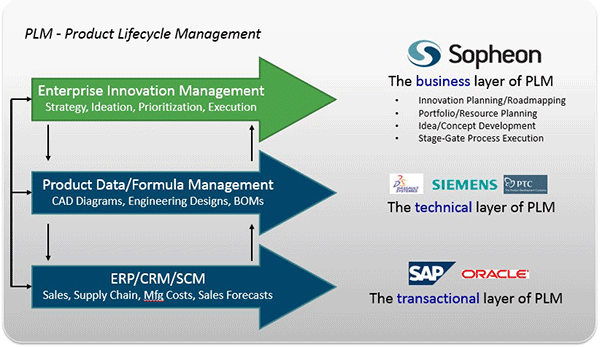I am often asked by customers what the difference is between discrete manufacturing and process manufacturing. One simple answer is to look at the way the end product is created. In discrete manufacturing, identical products are created, typically in an assembly line. The discrete parts or materials used to create these products are identical and the end result is a discrete number of end products that can typically be unassembled. On the other hand, process manufacturing can be more complex in nature. It typically involves a transformation or conversion of raw materials to produce an end product which cannot be unassembled back to the original raw materials.
When it comes to innovation and new product development, many principles apply to both. Both types of manufacturers typically use a standardized stage and gate process for development and testing of their products. They both must feed the front end of their funnel through market-driven ideation, and must both optimize their portfolios based on strategic targets and performance with a portfolio management process.
However, there are some fundamental differences that drive variations in their innovation processes. Here are some typical attributes:

Diagram 1
We can also compare and contrast the two from a product lifecycle perspective. Looking at our traditional delineation across the product lifecycle management (PLM) space, there are very significant differences in tools and processes at both the technical layer and the transactional layer of PLM, as indicated in Diagram 1. A snack company would highlight complexities in the technical layer of process manufacturing around recipe and ingredient management as well as artwork/labeling and packaging. Management of these disciplines requires specialty software. An auto or electronics company, on the other hand, will highlight similar complexities around bill of materials (system, sub-systems, sub sub-systems assemblies, etc.) and routing (manufacturing/assembly processes) at the technical layer. Again, these disciplines require very specialized software and processes to enable. The overall commercialization process for discrete and process manufactured differs significantly.

Diagram 2
However at the high-level, business layer of PLM, we actually find many similarities. Process and discrete manufacturing companies share the same innovation goals:
How do we:
- Create higher value new products?
- Increase our new product success rate?
- Get to market faster/more efficiently?
- Align investments with strategies?
- Focus resources on right projects?
- Make better prioritizations/gate decisions?
Meeting these goals involves managing the innovation process from idea to launch. This is where enterprise innovation management software becomes critical. Discrete and process manufacturing face similar challenges during the Innovation lifecycle:
- No connection or alignment between the work being performed and the strategic goals of the company
- Resource overload – people are “time-starved” and cannot focus on the most important work due to distraction by lower-value projects
- Resource bottlenecks – lack of planning leads to delays due to lack of access to resources
- Poor or no visibility to cross-functional work tasks/status creates project delays and crises, often at critical junctures
- Lack of standardized processes results in people needlessly reinventing the wheel
- Overly-rigid standardized processes cause unnecessary tasks/work
- Poor up-front, cross-functional planning results in commitments without understanding dependencies, and requires “heroic measures” to achieve unrealistic deadlines
- No visibility to process metrics (e.g. actual time to market) means no way to diagnose problems or continuously improve
Successful implementation of Enterprise Innovation Management enables effective cross-functional decision-making to define and manage innovation investments. It will address the hurdles listed above by ensuring resources are aligned to the highest value projects. Enterprise portfolio visibility and Impact analysis capabilities will ensure the portfolio is optimized and nimble. Typically when you think of innovation, you think of product Innovation.
However, innovation investments can actually fall in to several different categories including:
- Product Innovation Projects (discussed above) – Bringing new products and services to market. These can range from line extensions to new to the world products
- Discovery/Long Term Research Projects – Big Bet projects and initiatives focused on long-term investments to support new platforms or technologies
- Brand Stewardship Projects – Product and marketing projects focused on making sure your message and commitment to your customers is clearly understood and delivered on
- Productivity Projects – Projects to improve your company's operational performance/efficiency through R&D and/or process improvement initiatives
The nature of the projects in these categories will certainly differ between process and discrete manufacturing. Contrary to item 1 (the innovation process around products) which as discussed is very similar between process and discrete manufactured products, Discovery/Long Term Research Projects vary significantly between the two manufacturing types. This is primarily due to the nature of the products and portfolios. Both process and discrete manufacturing companies must make long-term investments including core technologies.
Certainly process manufacturing companies must invest in foundational technologies such as sweeteners or flavors. However, in discrete manufacturing companies such as electronics, industrial, or automotive companies, the complexity of the end products can be much higher and there is often a much higher dependency on technology platforms. This creates a need for disciplined product and technology roadmapping to identify dependencies and ensure all components are in place to get the products to market in a timely manner.
These technology/platform projects make up a much more significant portion of a discrete manufacturing company's portfolio. This creates significant challenges when forecasting revenue against investment projects and aligning with strategic targets. Revenues for these platform investments must be projected across multiple product projects. The process of managing your portfolio and performing impact analysis becomes much more complex, but also much more important. Make/Buy decisions, technology development decisions, etc. are critical to getting complex products to market ahead of the competition.
While the process and disciplines of innovation are similar between bringing a snack or beverage and the latest smart phone from idea to launch, there are certainly some major differences. The process of setting strategic objectives/targets, aligning projects in your portfolio with those plans, and optimizing short-term and long-term goals is significantly different.





